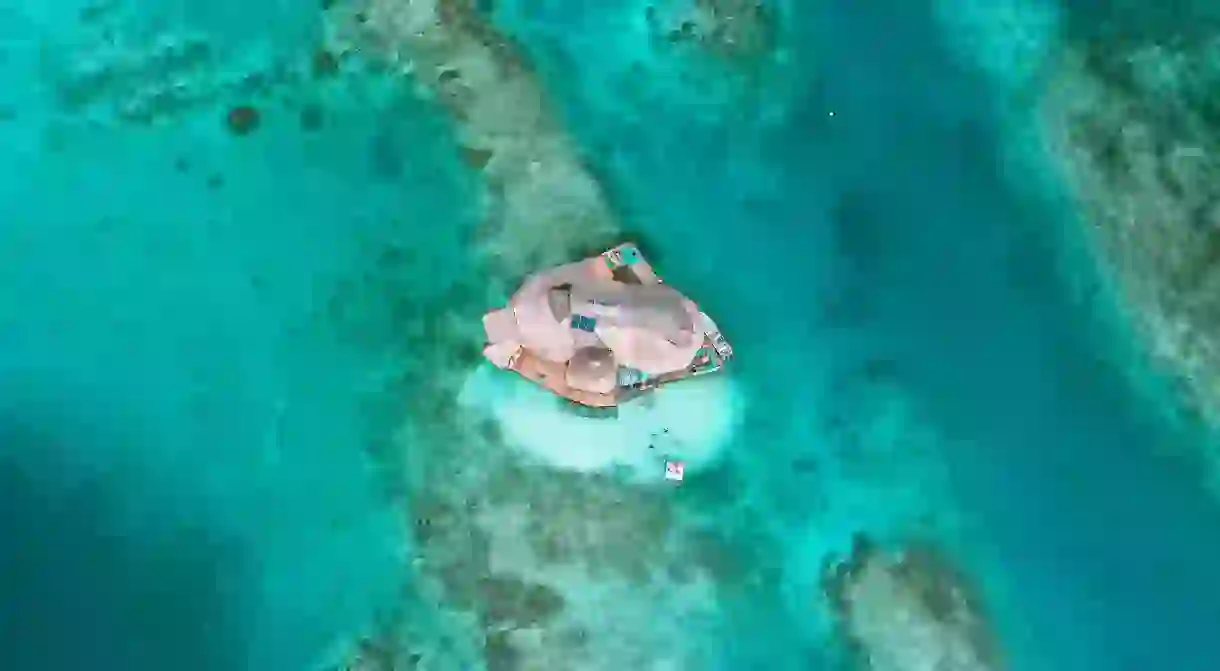Casa en el Agua: the Colombian Hostel in the Middle of the Ocean

The San Bernardo islands off Cartagena are less than 45 minutes away by boat – and well worth a visit. But instead of taking a day trip, why not stay in amongst them instead? Casa en el Agua may not have any wifi, but it does have plenty of hammocks.
Every morning at 9am, passengers gather at the dock in Cartagena, Colombia. We are greeted by a cheerful islander, who we quickly learn is the captain. We board his boat and the buildings of the city get smaller and smaller behind us as we head out to sea. Eventually, we pass some of the islands pictured in the brochures back on land. Hordes of tourists step off their boats and onto the beach, but we cruise past them as our captain picks up speed. The motor is so loud, we can’t talk to each other. Those sitting in the first couple of rows laugh as the water occasionally splashes them. But as some fellow Latinos like to say, “No pasa nada,” loosely meaning “Don’t worry about it.” I suddenly realize I’m in the middle of the ocean with nothing else in sight, but it’s a view we’ll soon get used to. We are going off the grid.
Roughly two hours later, the captain points to a former holiday home – a 25-year-old wooden house built on a concrete foundation and surrounded by ocean. A sign says Casa en el Agua, or “house on the water.” We have arrived.

The boat pulls up alongside a two-story colorful house with a thatched roof, and the passengers receive a warm welcome from staff. Lively music is playing, and the current guests look completely at ease. The first floor is expansive, with tables and chairs for games or moments of solitude. The second floor has bedrooms, hammocks, an area where visitors can jump off into the ocean and even a swing. Sleeping options include private rooms with a king-size bed, an eight-bed dorm room or a hammock at a very affordable price. There are also other sleeping arrangements, depending on the type of experience you’re seeking.
I quickly learn that one of the most important features of the hostel is the food. Our stay comes with a complimentary breakfast of fresh fruit and bread. Though we do have to pay for lunch and dinner, the combined price costs less than an average meal in the US. Options include seafood such as freshly caught lobster, crab and octopus, arepas stuffed with rice, beans, and plátano (plantains). There are also dishes to suit vegetarians.
On the first floor is a tiki bar, where a happy-go-lucky bartender serves everything from margaritas to caipirinhas and espresso martinis. I sip a cocktail with my feet dangling in the water, small fish swimming through my toes, and watching the sunset in varying pinks, purples, oranges and blues. The views seem to go on forever, and it’s almost hard to believe any other sort of civilization exists at Casa en el Agua.
During the day, guests can either stay here and relax or go off on an excursion: a 40-minute plankton tour, perhaps, or a three-hour snorkeling adventure. Guests can also visit beaches nearby. Some are overcrowded, but the one I visit only has a handful of people on it, with stretches of empty sand. A local takes my lunch order as I arrive, with options including freshly caught fish and drinks served in pineapples. Hammocks are found under mini palm trees, and the turquoise water calmly inquires when I’ll be coming in.

Perhaps the best excursion is a one- or two-hour walking tour of neighboring Santa Cruz del Islote. About 540 people live on this man-made island; built in 1870 of coral, debris or stone, it is roughly the size of two football fields, making it one of the most densely populated islands in the world. Most of its inhabitants work on the mainland, and there is one school with one teacher. In the past, children could only attend elementary school, having to go to Cartagena or Tulu to finish their education, but the school now offers high-school courses too. Many people have televisions and cell phones, but they are not consumed by them. Free time is spent fishing and swimming. They don’t have a police force, because they’ve never needed one. Solar cells supply the island with energy 24 hours a day.
“Islote is our enormous family,” says Ronald Hurtado Garcia, an administrator at Casa en el Agua. “That reason alone is why we bring travelers there. We want them to see how these people live together, how they support one another, how they work together and how they always have a smile on their faces.”
These people don’t have a lot and yet seem so content, making me think about tranquility and happiness. The boat from Casa en el Agua to Cartagena departs at noon each day. As I make the journey back, I contemplate the time I’ve spent – away from wifi, surrounded by ocean, swimming and enjoying satisfying conversations. With one glance back at the tranquil islands in the middle of nowhere, it strikes me that you don’t need very much to have it all.













